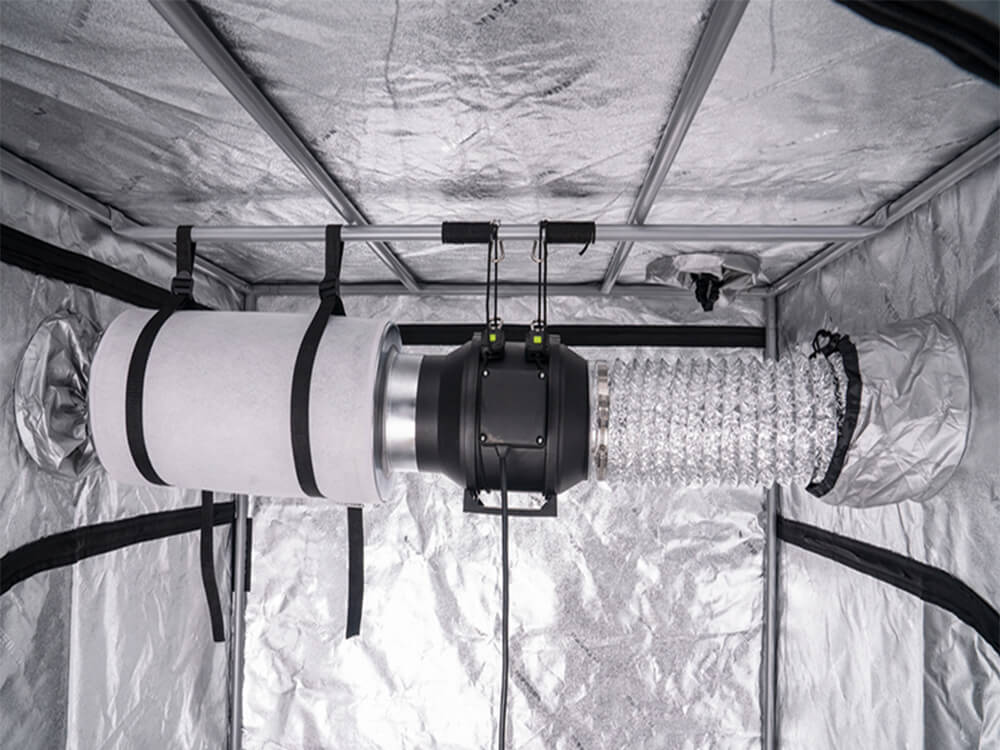🔥 Website for Sale - Contact Us
Setting up a grow tent ventilation system is like assembling a complex jigsaw puzzle. Each piece plays a crucial role in the outcome, creating an environment in which cannabis thrives. Grow tent ventilation system requires understanding the fundamentals of airflow, temperature, and humidity, as well as the essential components needed to create the perfect environment for cannabis plants.
In this beginner’s guide, we’ll break down the steps to becoming a grow tent ventilation expert. Let’s embark on an exciting adventure and set up the perfect grow tent ventilation system.
Understanding the Basics of Cannabis Plant Ventilation
A. The role of oxygen and carbon dioxide in plant growth
You may recall from those long-ago biology classes that plants are like reverse humans when breathing. They take in carbon dioxide (CO2) and release oxygen (O2), which is fantastic for us oxygen-breathing creatures. But how does this relate to cannabis plant ventilation? Simple: to maintain that sweet, sweet balance of CO2 and O2, we need a constant exchange of air. Your plants need to inhale the CO2 goodness and exhale the O2, creating a harmonious, productive environment for growth.
B. The significance of temperature and humidity control
Now, let’s stroll down memory lane to those sultry summer days when the heat was unbearable. Not much fun, right? Well, it’s the same for your cannabis plants. Too much heat and humidity can lead to a miserable existence, with the potential for mold, pests, and other undesirables. Properly ventilating your grow tent, and controlling the temperature and humidity levels to provide your leafy friends with a comfortable, inviting home.
C. The relationship between air circulation and pest prevention
Who doesn’t love a gentle summer breeze? It’s refreshing, invigorating, and essential to keep cannabis pest-free. Pests are like uninvited party guests – they love to hang around and cause trouble, especially in stagnant air. By ensuring proper air circulation in your grow tent, you’re effectively blowing these party crashers away, keeping your plants healthy and happy. So, crank up those fans and let the good times roll!
Key Components of a Grow Tent Ventilation System
So, you’ve made it this far and are ready to assemble your cannabis plant’s dream home. But first, you’ll need to know the essential building blocks of a grow tent ventilation system. It’s like putting together a jigsaw puzzle – each piece plays a crucial role in completing the picture-perfect environment for your plants.
A. Exhaust fans
Types of exhaust fans
Exhaust fans are like the bouncers of your grow tent. They’re responsible for escorting stale, hot air out of the party, making room for fresh air to join the festivities. There are two main types of exhaust fans: inline fans and centrifugal fans. Inline fans are typically smaller, quieter, and perfect for smaller grow tents. Centrifugal fans, on the other hand, are larger, more powerful, and better suited for larger tents or when you need some extra muscle to overcome resistance in your ducting system.
B. Intake fans
Passive vs. active intake
Intake fans are the ushers of your grow tent, welcoming fresh air into the party. There are two types of intake systems: passive and active. “Passive intakes” relies on vents or openings to let fresh air in, while “active intakes” use fans to suck fresh air into grow tent. The choice between passive and active intake depends on the size of your grow tent, the desired level of control, and the overall efficiency of your ventilation system.
Matching intake fans with exhaust fans
If your exhaust fans are the bouncers and your intake fans are the ushers, they work in harmony to maintain a balanced and comfortable environment. That means you’ll need to match the power and capacity of your intake fans to your exhaust fans, ensuring that they can effectively move the same volume of air.
C. Carbon filters
Function and importance in odor control
Let’s be honest – cannabis plants have a unique and potent aroma, which isn’t always appreciated by everyone. That’s where carbon filters come in. They act like the incense sticks of your grow tent, absorbing and neutralizing odors before they have a chance to escape and upset your neighbors. By incorporating a carbon filter into your ventilation system, you’ll be the considerate cannabis cultivator that everyone loves.
Selecting the appropriate size and placement
Choosing the right carbon filter size is a bit like Goldilocks and the Three Bears – it needs to be just right. Too small, and it won’t be able to handle the odors; too large, and it might restrict airflow. The key is to select a filter that matches the capacity of your exhaust fan, ensuring that it can effectively treat the air without hindering performance.
D. Ducting
So, you’ve got your fans and filters all figured out – but how do you connect these magical devices to create the ultimate grow tent ventilation system? Enter the unsung hero of ventilation: ducting. Like the veins and arteries of your grow tent, ducting transports fresh air in and stale air out, ensuring your plants remain in tip-top shape.
Material options and considerations
Ducting is made from various materials, each with its own unique set of pros and cons. Some common options include flexible aluminum, PVC, and insulated ducting. Imagine them as different types of highways, each catering to specific traffic needs.
Flexible aluminum ducting is the economical and versatile choice, bending easily to fit a grow tent’s layout. However, this flexibility can also lead to air leaks and reduced efficiency if not installed carefully.
PVC ducting is a more robust option, providing a smoother airflow and fewer chances of air leaks. But be warned – it’s a bit like working with a stubborn garden hose and can be tricky to maneuver into tight spaces. Finally, insulated ducting is the luxury car of the ducting world, offering a smooth ride and noise reduction. This option is perfect for those looking to minimize heat transfer and maintain a discreet grow operation.
Proper installation techniques
First, measure and cut your ducting to fit the distance between your fans and filters. It’s a bit like tailoring a suit – you want the perfect fit for maximum efficiency. Next, secure the ducting to your fans and filters using clamps or duct tape, ensuring a snug, airtight seal. Finally, route your ducting through the grow tent, avoiding sharp bends and kinks that could restrict airflow. Think of it as designing the perfect rollercoaster – smooth turns and minimal friction make for a thrilling ride.
E. Oscillating fans
Last but not least, let’s talk about the cherry on top of your grow tent ventilation system: oscillating fans. These nifty devices are the gentle breeze your plants crave, helping to circulate air within the tent and keeping leaves fluttering in delight.
Benefits of air circulation within the grow tent
Oscillating fans are the unsung heroes of your cannabis plants’ microclimate, ensuring that air is evenly distributed throughout the tent. This prevents stale air pockets and hotspots, creating a harmonious environment where your plants can thrive. Additionally, the gentle movement of air strengthens plant stems, much like a personal trainer for your leafy friends.
Optimal placement and settings
When it comes to oscillating fans, it’s all about location, location, location. Place your fans strategically within your grow tent, ensuring they don’t directly blow on your plants to avoid windburn. Instead, aim for a gentle rustling of leaves, creating an environment that mimics a soft breeze.
As for settings, it’s essential to find the sweet spot between too much and too little airflow. Experiment with different fan speeds and positions, observing how your plants react to each adjustment.
Designing Your Grow Tent Ventilation System
With a solid understanding of the key components under your belt, it’s time to don your architect hat and design the ultimate grow tent ventilation system. Like a maestro conducting a symphony, you’ll need to orchestrate the perfect balance of airflow, temperature, and humidity to create a harmonious environment for your cannabis plants.
A. Calculating the required airflow for your grow tent
Before you start sketching out your masterpiece, you’ll need to determine the airflow requirements for your grow tent.
First, find the volume of your grow tent by multiplying its length, width, and height (L x W x H). Next, aim to replace the air inside your tent at least once every minute. Multiply the volume by 60 to determine the required airflow in cubic feet per minute (CFM). Now you have a starting point for choosing the right fans and filters to accommodate your grow tent’s needs.
B. Balancing intake and exhaust for optimal air exchange
Designing a well-balanced ventilation system is like choreographing a perfectly timed dance routine – each component must work in harmony to achieve the desired effect. This means balancing your intake and exhaust fans to create an efficient air exchange.
Typically, your exhaust fan should be more powerful than your intake fan to create negative pressure inside the grow tent. This helps to draw fresh air in while expelling hot, stale air, keeping your plants cool and content. A good rule of thumb is to choose an intake fan with approximately half the CFM of your exhaust fan.
C. Ventilation system layout and ducting routing
With your fans and filters selected, it’s time to map out your ventilation system layout. Start by positioning your exhaust fan and carbon filter at the top of your grow tent, taking advantage of the fact that hot air rises. Next, place your intake fan near the bottom of the tent, allowing fresh air to flow upwards and evenly distribute throughout the space.
When it comes to routing your ducting, think like a rollercoaster designer – aim for smooth turns and minimal friction. Keep your ducting as short and straight as possible, avoiding sharp bends and kinks that can restrict airflow. Remember, an efficient ventilation system is key to a thriving cannabis garden.
D. Incorporating a humidity and temperature control system
To truly elevate your grow tent ventilation system, consider adding a humidity and temperature control system. It’s like upgrading from a bicycle to a sports car – you’ll enjoy enhanced performance and an even better environment for your plants. Invest in a hygrometer to monitor humidity levels and a thermostat to keep tabs on the temperature. Connect these devices to your fans, allowing them to automatically adjust according to your plants’ needs.
With this level of control, you’ll create a grow tent environment that rivals the most sophisticated indoor gardens. By carefully designing your grow tent ventilation system, you’ll cultivate a thriving oasis for your cannabis plants, setting the stage for bountiful harvests and the sweet smell of success.
Maintaining Your Grow Tent Ventilation System
Congratulations! You’ve designed and set up the perfect grow tent ventilation system for your cannabis plants. But the journey doesn’t end here. Like a well-oiled machine, your ventilation system requires regular maintenance and care to keep it running smoothly. After all, even the most luxurious cars need an occasional tune-up.
A. Regular cleaning and maintenance tips
The key to a healthy, efficient ventilation system is keeping it clean and free of dust, debris, and other pesky particles. Treat your grow tent like a five-star hotel, ensuring every component is spotless and functioning at its best.
Fans: Clean your exhaust and intake fans regularly, removing any dust or debris that may have accumulated on the blades. This not only helps to keep the air clean but also ensures your fans are running at peak efficiency.
Filters: Replace your carbon filters according to the manufacturer’s recommendations, typically every 9-12 months. This guarantees that your odor control remains top-notch, and your plants continue to enjoy the clean, fresh air.
Ducting: Inspect your ducting for any damage, leaks, or obstructions, repairing or replacing as necessary. A well-maintained duct system is essential for efficient airflow and temperature control.
B. Troubleshooting common issues
Inadequate airflow: If you notice your plants struggle or grow tent become too hot, check your fans and ducting for obstructions, damage, or debris. Regular cleaning and maintenance can help prevent these issues from arising.
Unwanted odors: If odors persist despite your best efforts, it may be time to replace your carbon filter or reevaluate your exhaust fan’s power. A fresh filter and a proper-sized fan can make all the difference in keeping your grow tent smelling fresh.
Imbalanced temperature and humidity: Monitor your grow tent’s conditions regularly and adjust your ventilation system as needed. Consider incorporating automated controls for even greater precision and peace of mind.
C. Upgrading and optimizing your system over time
As you gain experience in cannabis cultivation, you may find opportunities to upgrade and optimize your grow tent ventilation system. Consider investing in higher-quality fans, ducting, or filters, or exploring more advanced temperature and humidity control systems.
A. Understanding local cannabis cultivation laws
Cannabis cultivation laws vary significantly by country, state, and even city, and navigating this complex landscape can feel like walking through a legal labyrinth.
Take the time to research your area’s cannabis cultivation laws, paying particular attention to limits on the number of plants, licensing requirements, and restrictions on where you can grow. By understanding and adhering to these regulations, you’ll avoid potential legal headaches and cultivate your cannabis with confidence and peace of mind.
B. Electrical safety precautions
A grow tent ventilation system, like any electrical setup, comes with inherent risks. To ensure your cannabis cultivation doesn’t end in a shocking disaster, it’s essential to follow proper electrical safety precautions. Use high-quality, certified electrical components, such as fans, timers, and extension cords, to minimize the risk of malfunction or fire.
Avoid overloading circuits and ensure the grow tent’s electrical needs are within the limits of your home’s electrical system.
Keep all electrical connections dry and elevated off the floor to prevent potential water damage or short circuits.
Regularly inspect your electrical components for signs of wear, damage, or fraying, and replace them as needed.
C. Fire safety measures
A grow tent ventilation system is designed to manage heat and air circulation, but it’s still essential to consider fire safety measures. Treat your grow tent like any other room in your home, taking precautions to minimize the risk of fire. Equip your grow tent with a fire extinguisher and smoke detector, ensuring they’re easily accessible and in proper working order. Keep flammable materials, such as fabric or paper, away from heat sources and electrical components.
Regularly check your grow tent’s temperature and ensure your ventilation system is functioning correctly to prevent overheating.
By prioritizing legal and safety considerations, you’ll create a secure and responsible environment for your cannabis cultivation journey. With these precautions in place, you can focus on perfecting your grow tent ventilation system and cultivating a thriving, bountiful garden.
Conclusion
Embarking on the adventure of cannabis cultivation can be an incredibly rewarding and fulfilling experience. By mastering the art of grow tent ventilation, you’ll create an environment where your plants can flourish, producing bountiful harvests and a sense of accomplishment.
From understanding the basics of cannabis plant ventilation to carefully selecting and installing key components, you’ve learned the secrets to designing an efficient and effective grow tent ventilation system. With ongoing maintenance, troubleshooting, and optimization, your system will continue to serve your plants well, providing them with the ideal conditions for growth.
Here’s to your future green-thumb endeavors and the sweet aroma of success!





